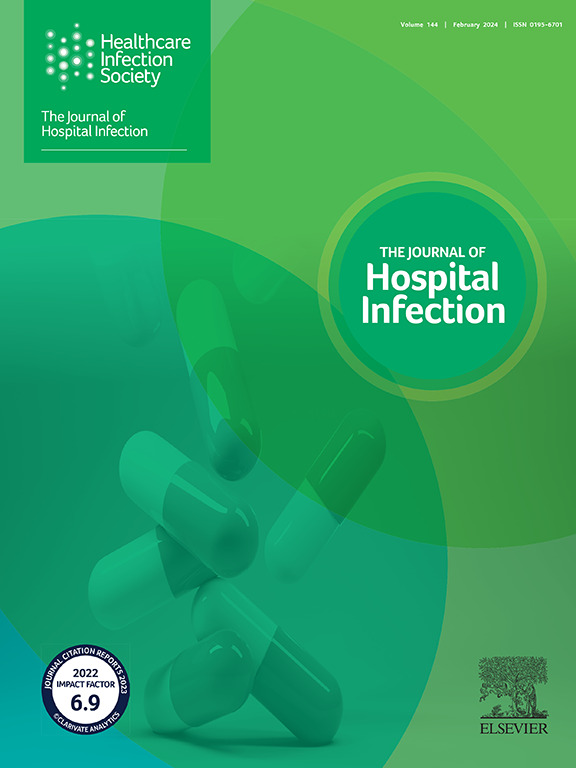膝关节镜手术患者感染的风险因素:系统回顾和元分析。
IF 3.9
3区 医学
Q1 INFECTIOUS DISEASES
引用次数: 0
摘要
目的:主要目的是确定膝关节镜手术后的感染风险,并评估手术部位感染(SSI)的风险因素:方法:系统检索了 PubMed/Medline、Embase 和 Cochrane 图书馆数据库,以及以往系统综述和荟萃分析手册研究的参考文献列表。结果:共有 38,321 篇潜在文章符合初步纳入标准。在对标题、摘要和全文进行审查后,剩余的 41 篇文章被纳入最终分析。我们在 41 篇文章中确定了 9089578 名接受膝关节镜手术的患者。高质量(I级)证据显示,自体移植物(十字韧带重建)(OR,2.66% CI,1.84-3.86)或手术复杂度高(OR,2.02;95% CI,1.69-2.43)的感染风险更高,而中等质量(II级或III级)证据显示,肥胖(体重指数≥30 kg/m2)(OR,1.27;95% CI,1.08-1.49)或男性(OR,1.52;95% CI,1.32-1.75)或糖尿病(OR,1.71;95% CI,1.36-2.14)或吸烟(OR,1.65;95% CI,1.38-1.97)或术前使用类固醇(OR,3.41;95% CI,2.10-5.54)有更高的感染风险。荟萃分析表明,年龄或抗生素预防与感染发生率之间没有关联:荟萃分析表明,膝关节镜手术后感染的重要风险因素包括肥胖、男性、糖尿病、吸烟、手术复杂度高、移植物类型和术前使用类固醇:IV级,对III级和IV级研究的系统回顾。本文章由计算机程序翻译,如有差异,请以英文原文为准。
Risk factors for infection in patients undergoing knee arthroscopy: a systematic review and meta-analysis
The primary aim of this study was to determine the risk of infection after knee arthroscopy and to evaluate the risk factors for surgical site infection (SSI). The PubMed/Medline, Embase and Cochrane Library databases were systematically searched, as were the reference lists of previous systematic reviews and meta-analysis manual studies. A random-effects model was used to calculate the estimated pooled odds ratio (OR). A total of 38,321 potential articles met the initial inclusion criteria. After a review of the titles, abstracts and full texts, the remaining 41 articles were included in the final analysis. We identified 9,089,578 patients who underwent knee arthroscopy in 41 articles. High-quality (class I) evidence showed that autografts (cruciate ligament reconstruction) (OR, 2.66;95% CI, 1.84–3.86) or high procedure complexity (OR, 2.02; 95% CI, 1.69–2.43) had a higher risk of infection, while medium-quality (class II or class III) evidence showed that obesity (body mass index ≥30 kg/m2) (OR, 1.27; 95% CI, 1.08–1.49) or male (OR, 1.52; 95% CI, 1.32–1.75) or diabetes (OR, 1.71; 95% CI, 1.36–2.14) or tobacco use (OR, 1.65; 95% CI, 1.38–1.97) or preoperative steroid use (OR, 3.41; 95% CI, 2.10–5.54) had a higher risk of infection. The meta-analysis showed that there was no association between age or antibiotic prophylaxis and infection incidence. The meta-analysis showed that significant risk factors for infection after knee arthroscopy included obesity, male sex, diabetes, tobacco use, high procedure complexity, graft type, and preoperative steroid use.
求助全文
通过发布文献求助,成功后即可免费获取论文全文。
去求助
来源期刊

Journal of Hospital Infection
医学-传染病学
CiteScore
12.70
自引率
5.80%
发文量
271
审稿时长
19 days
期刊介绍:
The Journal of Hospital Infection is the editorially independent scientific publication of the Healthcare Infection Society. The aim of the Journal is to publish high quality research and information relating to infection prevention and control that is relevant to an international audience.
The Journal welcomes submissions that relate to all aspects of infection prevention and control in healthcare settings. This includes submissions that:
provide new insight into the epidemiology, surveillance, or prevention and control of healthcare-associated infections and antimicrobial resistance in healthcare settings;
provide new insight into cleaning, disinfection and decontamination;
provide new insight into the design of healthcare premises;
describe novel aspects of outbreaks of infection;
throw light on techniques for effective antimicrobial stewardship;
describe novel techniques (laboratory-based or point of care) for the detection of infection or antimicrobial resistance in the healthcare setting, particularly if these can be used to facilitate infection prevention and control;
improve understanding of the motivations of safe healthcare behaviour, or describe techniques for achieving behavioural and cultural change;
improve understanding of the use of IT systems in infection surveillance and prevention and control.
 求助内容:
求助内容: 应助结果提醒方式:
应助结果提醒方式:


